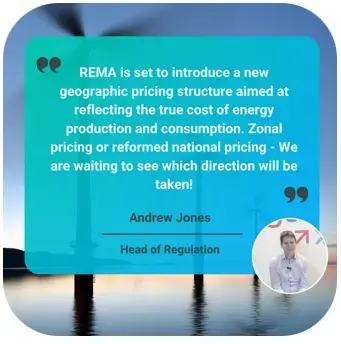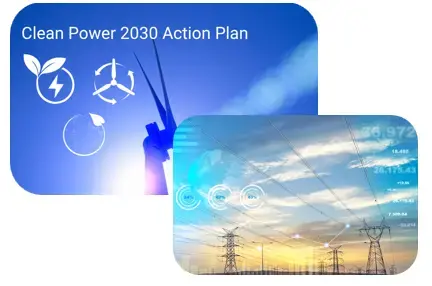
A Quick Look at REMA
Review of Electricity Market Arrangements
Updated:18/07/25
Published date: 03/06/25
Read time: 4 minutes
Back in April 2022, REMA was launched in the British Energy Security Strategy which outlined an initiative to significantly change the electricity market in Great Britain. From its design to pricing mechanisms to long-term reform, REMA, the Review of Electricity Market Arrangements aims to transform market structures to support Clean Power 2030, while maintaining supply security and a fair deal for consumers.
In this blog, Andrew Jones, Head of Regulation, takes a look at the key areas of REMA from the initial consultation phase to the latest proposals and reforms, highlighting the changes in pricing models, the integration of renewables and the critical reforms aimed at achieving net zero emissions and a low-carbon energy future.
Over to you Andrew...
The first consultation round, held in July 2022, gathered insights from industry stakeholders, policymakers, and consumers. The initial phase looked to identify key priorities and challenges in reforming the electricity markets and participants discussed various aspects such as the need for greater flexibility, integration of renewable energy, and the importance of maintaining affordability and reliability. The feedback from this round laid the groundwork for subsequent proposals and adjustments, ensuring that the reforms align with the overarching goals of achieving net zero emissions and enhancing energy security.


Fast forward to 2025, and the UK government continues to focus on REMA, with the latest Autumn update published in 2024 and on-going stakeholder webinars held in early February of this year.
On 10th July, the Department for Energy Security and Net Zero (DESNZ) announced a key decision: instead of a zonal wholesale market with varying prices nationwide, the UK will retain a single national price to in part avoid investor uncertainty in Net Zero technologies. Reformed national pricing aims to maintain a unified national price while incorporating adjustments to better align with the true costs and availability of electricity across different regions via stronger TNUoS signals. This approach is set to offer a more balanced and equitable distribution of costs and benefits for consumers and producers alike.
This has been an eagerly anticipated decision, and a national pricing plan giving greater details on how reformed pricing will work is expected by year-end.
The government is still considering demand dynamics and proposed reforms to the balancing mechanism which included shorter settlement periods, dual imbalance prices, and improved interconnector flow management. The Contracts for Difference (CfD) scheme is expected to undergo significant changes by Allocation Round 9 (AR9) in 2027, with options like capacity-based CfDs and deemed CfDs being considered. There are also planned reforms to the Capacity Market to support decarbonisation by setting minimum procurement targets for flexible low-carbon technologies. These updates are designed to enhance market efficiency, reliability, and investment confidence while supporting the UK's transition to a low-carbon energy system.
With this in mind, let's take a quick look at the overall key aspects of REMA.
Key components, proposals & priorities...
Wholesale Market Reform: Introducing new pricing models that better reflect the cost of renewable energy and incentivise low-carbon technologies.
Capacity Mechanisms: Capacity mechanisms that reward businesses for reducing demand during peak times or providing backup power.
Renewable Integration: Integration of renewable energy sources into the grid. This may involve subsidies or incentives for businesses that adopt renewable technologies.
Wholesale Market Pricing: Zonal pricing is still under consideration with plans to divide the UK into zones with independent electricity prices based on regional supply and demand. Reformed national pricing is also still under consideration with plans set out to maintain a signal national price but with adjustment to TNUoS, to better reflect supply and demand dynamics.
Balancing Mechanism: Proposals include shorter settlement periods, dual imbalance prices, and improved interconnector flow management.
Contracts for Difference (CfD) Scheme: Retaining the marginal pricing model and proposing changes to the CfD scheme to keep electricity prices down for end-users. Significant changes are expected by Allocation Round 9 (AR9) in 2027.
Capacity Market Reforms: Supporting decarbonisation with minimum procurement targets for low-carbon technologies.
Government Priorities...
Minimising Transitional Uncertainty: Ensuring investor confidence while implementing reforms.
Clean Power 2030 Action Plan: Aligning REMA reforms with broader energy goals from DESNZ.
Response: Encouraging stakeholders to respond to the consultation to ensure energy security and affordability for consumers.
Investment: Shape future policy and ensuring timely delivery to catalyse investment in the energy sector.

Final Thoughts...
Over the next year or two, significant developments are expected as REMA continues to roll out its ambitious plans. Business consumers in the UK can now expect new reformed national pricing to ensure that non-wholesale electricity prices better align with the dynamics of supply and demand across the country.
With the upcoming Allocation Round 9 (AR9) in 2027, changes to the Contracts for Difference (CfD) scheme will be implemented to help maintain lower electricity prices too. The focus will also be on supporting decarbonisation through the Capacity Market Reforms, with specific targets for flexible low-carbon technologies.
Stakeholder engagement will remain crucial as the government continues to refine and implement these reforms, with ongoing consultations and feedback loops designed to address the complexities and challenges of transitioning to a low-carbon energy system.
REMA's success will be measured by its ability to adapt and evolve, to foster investment, and to secure a greener, more dependable energy landscape for the UK. As we move forward, collaborative efforts of policymakers, industry leaders, and consumers alike will be vital in shaping an energy future that is both sustainable and equitable.
I'd encourage all businesses to keep an eye on the updates coming from government on REMA developments this summer when a decision on Zonal or Enhanced National models is expected. Understanding this will help identify new investment opportunities, while early awareness of policy shifts will allow businesses to leverage government incentives. As REMA aims to align electricity prices with supply and demand dynamics, businesses can better manage their energy costs by anticipating these changes.
Keep an eye on our Blog page for further updates, and follow us on LinkedIn to keep up to date with all our latest content.